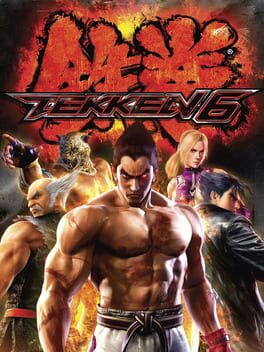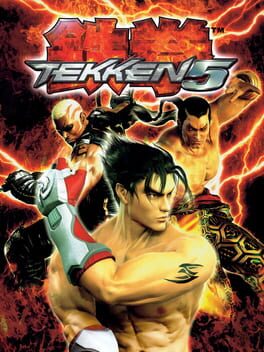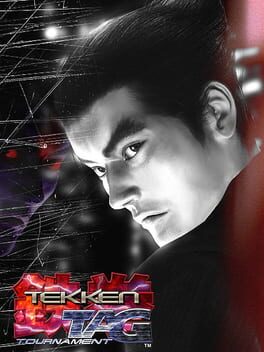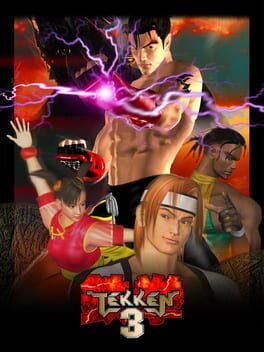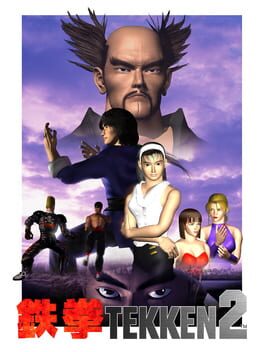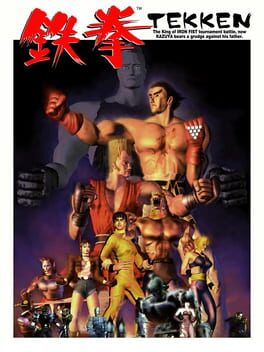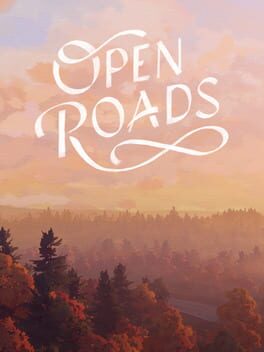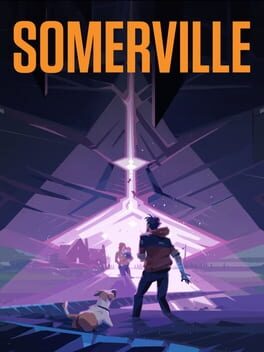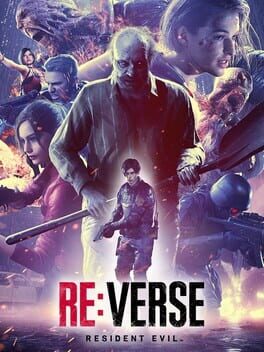thebestmark
2007
Tekken 6 is the first weirdly plot-heavy Tekken game, with its own story campaign and everything, but saddled with sloppy-feeling Tekken force combat and fixated with pseudo-military combat between Tekken corporations, which is just about the least interesting possible thing this series has going on. Otherwise, Tekken 6 is probably the single most indistinct Tekken of them all, not particularly creative as far as the stages go, not particularly memorable in the character designs. If I wanted to play any random Tekken game at my disposal, this is probably the very last one I'd pick.
2005
I've always loved the fact that Tekken has exactly one full-on narrative-driven action game that isn't a fighting game and it stars Nina. I love that. So many weird things happen to Nina in these godforsaken Tekken games. The combat in this game is novel, but it's sort of similar to that Jet Li game "Rise to Honor," except not quite as good. The setting is cool, but I found everything confusing to navigate when I played this years ago. Not necessarily a 'good' game, but a fun novelty, imo.
2004
Here's the thing with Tekken 5. I always felt like, after the weirdness of Tekken 4, Tekken 5 was a kind of shortening of the horizons as far as what the series can do, a tacit acknowledgement that the series couldn't afford to get weird or dark or experimental at all. However, it's also the Tekken game everyone can agree on. It does everything you'd want a Tekken game to do, and it does that stuff really well. It's also got a ton of single player content in it that's a lot of fun to mess with, and even though the plot in this game is particularly braindead, all of the little character cutscenes are really well made. The core mechanics really synch together here, too - every Tekken game up to the fifth one changes some fundamental aspect of the game or another, but Tekken 5 is the game that established the baseline for the series moving forward.
2001
You literally could not make this game again today. Contemporary fighting games exist in this squishy space between sports and art, and between the two, all the money's in sports. You just don't get to cultivate the weird, tense atmosphere this game has, or its preponderance of plot and the subdued character designs, if the game also has to be projected onto giant screens in convention halls with live commentators chatting about the whole thing. The story's still goofy as hell and the Americanization of the characters in the cutscenes always struck me as a little bizarre, but Tekken 4 is a highlight of the entire series, as far as I'm concerned.
A lot of fun in and of itself, but the increased chaos and non-canonicity of the Tag games devalue them to me. This first game in particular seemed designed to show off the technical advancements in the leap from Tekken 3 on the PS1 to the shiny new PS2 graphics, which obviously ages the game quite a bit. There's also way less in the way of single player content in the console version than either Tekken 3 or Tekken 4. Probably one of the last games in the series I'd boot up if I wanted to play some Tekken.
1997
An absolute all-timer fighting game that took Tekken from being Virtua Fighter's weird, ugly cousin, and into a dynamic series with its own identity. Still has some of the best gamefeel in fighting games, and nearly all of the characters, both new and returning, are rocking some really fun, iconic looks. There's a generous amount of side content and single player stuff to mess with, and the unlockable cinematics which would become the series' big staple are super fun and interesting. I've always felt like the only thing missing was a more consistent soundtrack; aside from Jin Kazama and Law, none of these characters get the memorable themes they deserve.
1995
Everything that made Tekken a bad game persists here, most especially the low gravity combat and unresponsive controls, but the series takes a big leap forward in the visual department. There's coherent characterization! Characters develop iconic looks! Stages have definition! It still feels clunky as hell to play, though.
1994
The original Tekken is very unpleasant to actually play, what with its bizarre low gravity jumps and sludge-like response between input and action. The best part about it is its aesthetics. This game has some of the ugliest character models in a major fighting game series and levels so hilariously boxy and eye-blindingly bright that they look rather like children's drawings - and yet, the music is so, so, so celebratory, so confident in its spectacle, that I'm charmed by it. "Ta-daaaa!" Tekken's score says, as I am knocked, slow-motion, into the moon by a man with a lumpy triangle for a body.
Sets aside the austere darkness of the full game to make a Alan Wake II-themed Remedy variety show. This is basically a bit of wish fulfillment for Remedy fans: we get a little more love for Rose, the delightful Alan-obsessed waitress the plot so often likes to leave in the margins, a little Resident Evil level for Jessie Faden to trudge through, and finally a little bit of direction for poor sheriff Tim Breaker/pseudo-Jack Joyce's b-plot. Night Springs is sort of like eating potato chips after the five course meal that was Alan Wake II, but hey, they were good chips.
2024
1000xResist is the single greatest page-turner in the history of video games, with a barnburner of a story that's somehow both epic in scale and dense with detail. Speaking of this game even just purely in the lineage of the sci-fi timeline-hopping genre fiction of which it is a part, it is so profoundly good that it makes me mad at it. I don't want to just sit here and gush about it, but the fact that this game is as heady as it is, as emotionally resonant as it is, as beautifully written as it is, as imagistic as it is, and as structurally ingenious as it is, that it can exhibit so many authentically literary and cinematic qualities at once, is astounding.
And this is a game that asks some big questions! One of the most productive and fascinating questions 1000xResist asks is whether or not a person can do something that is truly, fundamentally unforgivable, a question that cuts to the heart of our current moment, and a question that's very difficult to answer.
1000xResist presents Iris, the last human woman granted immortality by a hivemind being beyond comprehension, as our vessel, or our framework, for the unforgivable act. Iris is a woman born into comfort who nevertheless is capable of cruelty, cruelty which her children - her clones - inherit, constructing an ever-growing chain of transgressions and consequences, a self-perpetuating cruelty which blossoms outward into all life in the new world.
A brief list of Iris' direct acts of cruelty, both big and small, includes, in chronological order: the exploding of a hamster, the bullying of a close friend, the murder of a scientist unshackled from morality for the perceived benefit of mankind, the genocide of the final remnants of the human race, and the removal of immunity from a deadly virus for the entirety of the new human race.
In short, Iris is responsible for the end of all human life - maybe all life, in total - as we know it. But in spite of the fact that 1000xResist takes place largely within Iris' memories, it won't open the door to her soul; it won't show you her regret, or her pride, only her actions and the immediate context for her actions as she experienced them in the moment. All of the sins Iris commits are catastrophic beyond reason, but they don't explain her to us. We don't get the satisfaction of knowing, beyond a shadow of a doubt, Iris' intentions.
1000xResist not only gives us imperfect information about Iris' actions, but it always leaves contradictory information lingering along the edges of each new act of cruelty. Through the 'communion' in which Watcher experiences Iris' memories, we learn that, when Iris was a child, she put her hamster in the microwave and exploded it. Pointless acts of cruelty towards animals typically signify sociopathy or psychopathy in fiction - they're symbolically used as a kind of raw, unfettered example of evil, and so we initially experience Iris' murder of the hamster as evidence of her monstrousness. Yet, we don't experience Iris' memories of the actual killing of the hamster. Instead, we experience a memory from before the killing, in which she lovingly interacts with the hamster, and a memory from after the killing, in which she overhears her parents discuss how to punish her. If you pay close attention, you'll also catch the fact that, later in life, Iris became a vegetarian.
In the immediate, witnessing Iris' actions instantly morally condemns her, that her antipathy towards animal life demonstrates a general antipathy to others. But upon reflection, Iris' relationship with animals becomes opaque. Would we linger on the memory of Iris’ parents, who are disturbed by her actions, if she was disinterested in how she affects others? Is she really a person who doesn’t care about animal welfare but nevertheless becomes vegetarian? It’s only through these indirect details that we can parse together what might be regret. But then again, we also learn midway through the story that Iris can choose to omit memories during communions. She chose to show these memories to her children - or, at least, she was OK with her children seeing them, this potentially regretful action. And so the pendulum also swings the other way, and the evidence seems to further condemn her rather than absolve her. Many of Iris' oldest children obey Iris not out of love, but out of fear for her power and cruelty, power and cruelty which these memories, potentially tinged with regret as they might be, also demonstrate. So are they regrets? Or are they implicit threats? Can you say for sure whether one or the other interpretation is correct?
Of course, the killing of the hamster is only the tip of the iceberg, and action of relatively little consequence in an exponentially more consequential series of cruelties. We get another, similar series of memories involving Jiao, Iris' best friend and receptacle for her callousness; Iris literally refers to her as a 'dumpster.' Iris bullies and psychologically abuses Jiao, but always keeps a picture of her nearby after the apocalypse, speaking with it, conjuring Jiao's ghost in her mind for moral support. And so, we're to understand, in spite of her cruelty towards them, that Iris loved Jiao. She indicates as much in her diary, which is read to us within Iris' memories. But we also learn that Jiao, on their deathbed, very specifically pleads to Iris: "I don't want to be a picture." And this is exactly how Iris conjures Jiao, in her mind, as a picture in a frame. Jiao, being a memory, is immaterial, can take any shape within Iris' mind, but Iris conjures Jiao exactly within the form that Jiao did not want to embody.
These maddening ambiguities ultimately do not assuage the intensity of Iris' cruelty, which her children - most especially her oldest/youngest child - inherit. All that's left of society is Iris' children and Iris' memories, and these relatively small moments of consequence possess huge repercussions, because Iris’ clones are all that's left. When one human being is rude to another, in the real world, it's a matter of small consequence, but in a world in which only, say, six people exist, that rudeness is only the beginning of a history that will evolve into exponentially bigger friction within what remains of society. Those little moments of friction are suddenly of dire importance; they are, as we learn, the seeds of authoritarianism.
As the Watcher, the player is made to play the dual role of critical analyst and judge. As Iris' psychological makeup, attitudes, relationships and material actions evolve through the vector of her clones into discrete factions upon which a society develops, the player is tasked with arbitrating forgiveness, not particularly for Iris or for the society which was born from Iris, but arbitrating forgiveness as a concept, determining the exact boundaries between which forgiveness is productive or necessary. You have to figure out, for yourself, where the buck stops. What cannot be allowed to prosper, ideologically-speaking, in order for a better world to exist?
Writers typically communicate to their audience, in broad and direct terms, who/what they're supposed to think is good, and who/what they're supposed to think is bad. Even in works which explore 'morally grey' characters, a set of values and ethics are inevitably communicated to the reader, and value judgements on which transgressions are necessary and which aren't are usually easy to make. In Hamlet, we know Claudius, the man who killed Hamlet’s father to steal his throne, is wrong not only because he killed the king, but because he knew, as its communicated to us via monologue, that doing so was wrong, and only to satisfy selfish desires. If an antagonist doesn't know what they've done is wrong, or if they actually experience, in good faith, what they've done as good, and if the work itself won't communicate indirectly to the audience its set of ethics, then it gets closer to approximating the actual function of justice in the world as we understand it. During the finale, the moral qualities of an individuals’ actions are set aside in favor of exploring the ideological root cause of them, to determining where oppression begins within the social.
1000xResist doesn't give us easy answers to its questions, but it does gives us one concrete antagonistic force upon which we can make our moral judgements: it emphatically does not believe in authoritarianism, of domination, of any kind. The engine which drives every act of cruelty in this game is force, either physical, psychological or structural. In doing so, it uses its ambiguity productively. Regardless of the outcome, the necessary component upon which all good outcomes are reliant upon is our ability to resist tyranny. Even the killing of Iris, a woman capable of profound cruelty who through sheer accident became both an angel of death announcing the end times and a Christ-like embodiment of sin and redemption, doesn’t actually, fundamentally alter the oppressive dynamics of power within the world. And during the ending sequence, in which the player gets to literally turn off the light switch on a variety of characters representing different ideological positions, the player can choose wrong by leaving some of the figures of oppression alive, and surrender the world once again to a dialectic of masters and slaves.
In a very powerful and illustrative fashion, 1000xResist demonstrates that there are hard limits on forgiveness as a utility. It is unfortunate, but true, that being a good person means having to fight back.
And this is a game that asks some big questions! One of the most productive and fascinating questions 1000xResist asks is whether or not a person can do something that is truly, fundamentally unforgivable, a question that cuts to the heart of our current moment, and a question that's very difficult to answer.
1000xResist presents Iris, the last human woman granted immortality by a hivemind being beyond comprehension, as our vessel, or our framework, for the unforgivable act. Iris is a woman born into comfort who nevertheless is capable of cruelty, cruelty which her children - her clones - inherit, constructing an ever-growing chain of transgressions and consequences, a self-perpetuating cruelty which blossoms outward into all life in the new world.
A brief list of Iris' direct acts of cruelty, both big and small, includes, in chronological order: the exploding of a hamster, the bullying of a close friend, the murder of a scientist unshackled from morality for the perceived benefit of mankind, the genocide of the final remnants of the human race, and the removal of immunity from a deadly virus for the entirety of the new human race.
In short, Iris is responsible for the end of all human life - maybe all life, in total - as we know it. But in spite of the fact that 1000xResist takes place largely within Iris' memories, it won't open the door to her soul; it won't show you her regret, or her pride, only her actions and the immediate context for her actions as she experienced them in the moment. All of the sins Iris commits are catastrophic beyond reason, but they don't explain her to us. We don't get the satisfaction of knowing, beyond a shadow of a doubt, Iris' intentions.
1000xResist not only gives us imperfect information about Iris' actions, but it always leaves contradictory information lingering along the edges of each new act of cruelty. Through the 'communion' in which Watcher experiences Iris' memories, we learn that, when Iris was a child, she put her hamster in the microwave and exploded it. Pointless acts of cruelty towards animals typically signify sociopathy or psychopathy in fiction - they're symbolically used as a kind of raw, unfettered example of evil, and so we initially experience Iris' murder of the hamster as evidence of her monstrousness. Yet, we don't experience Iris' memories of the actual killing of the hamster. Instead, we experience a memory from before the killing, in which she lovingly interacts with the hamster, and a memory from after the killing, in which she overhears her parents discuss how to punish her. If you pay close attention, you'll also catch the fact that, later in life, Iris became a vegetarian.
In the immediate, witnessing Iris' actions instantly morally condemns her, that her antipathy towards animal life demonstrates a general antipathy to others. But upon reflection, Iris' relationship with animals becomes opaque. Would we linger on the memory of Iris’ parents, who are disturbed by her actions, if she was disinterested in how she affects others? Is she really a person who doesn’t care about animal welfare but nevertheless becomes vegetarian? It’s only through these indirect details that we can parse together what might be regret. But then again, we also learn midway through the story that Iris can choose to omit memories during communions. She chose to show these memories to her children - or, at least, she was OK with her children seeing them, this potentially regretful action. And so the pendulum also swings the other way, and the evidence seems to further condemn her rather than absolve her. Many of Iris' oldest children obey Iris not out of love, but out of fear for her power and cruelty, power and cruelty which these memories, potentially tinged with regret as they might be, also demonstrate. So are they regrets? Or are they implicit threats? Can you say for sure whether one or the other interpretation is correct?
Of course, the killing of the hamster is only the tip of the iceberg, and action of relatively little consequence in an exponentially more consequential series of cruelties. We get another, similar series of memories involving Jiao, Iris' best friend and receptacle for her callousness; Iris literally refers to her as a 'dumpster.' Iris bullies and psychologically abuses Jiao, but always keeps a picture of her nearby after the apocalypse, speaking with it, conjuring Jiao's ghost in her mind for moral support. And so, we're to understand, in spite of her cruelty towards them, that Iris loved Jiao. She indicates as much in her diary, which is read to us within Iris' memories. But we also learn that Jiao, on their deathbed, very specifically pleads to Iris: "I don't want to be a picture." And this is exactly how Iris conjures Jiao, in her mind, as a picture in a frame. Jiao, being a memory, is immaterial, can take any shape within Iris' mind, but Iris conjures Jiao exactly within the form that Jiao did not want to embody.
These maddening ambiguities ultimately do not assuage the intensity of Iris' cruelty, which her children - most especially her oldest/youngest child - inherit. All that's left of society is Iris' children and Iris' memories, and these relatively small moments of consequence possess huge repercussions, because Iris’ clones are all that's left. When one human being is rude to another, in the real world, it's a matter of small consequence, but in a world in which only, say, six people exist, that rudeness is only the beginning of a history that will evolve into exponentially bigger friction within what remains of society. Those little moments of friction are suddenly of dire importance; they are, as we learn, the seeds of authoritarianism.
As the Watcher, the player is made to play the dual role of critical analyst and judge. As Iris' psychological makeup, attitudes, relationships and material actions evolve through the vector of her clones into discrete factions upon which a society develops, the player is tasked with arbitrating forgiveness, not particularly for Iris or for the society which was born from Iris, but arbitrating forgiveness as a concept, determining the exact boundaries between which forgiveness is productive or necessary. You have to figure out, for yourself, where the buck stops. What cannot be allowed to prosper, ideologically-speaking, in order for a better world to exist?
Writers typically communicate to their audience, in broad and direct terms, who/what they're supposed to think is good, and who/what they're supposed to think is bad. Even in works which explore 'morally grey' characters, a set of values and ethics are inevitably communicated to the reader, and value judgements on which transgressions are necessary and which aren't are usually easy to make. In Hamlet, we know Claudius, the man who killed Hamlet’s father to steal his throne, is wrong not only because he killed the king, but because he knew, as its communicated to us via monologue, that doing so was wrong, and only to satisfy selfish desires. If an antagonist doesn't know what they've done is wrong, or if they actually experience, in good faith, what they've done as good, and if the work itself won't communicate indirectly to the audience its set of ethics, then it gets closer to approximating the actual function of justice in the world as we understand it. During the finale, the moral qualities of an individuals’ actions are set aside in favor of exploring the ideological root cause of them, to determining where oppression begins within the social.
1000xResist doesn't give us easy answers to its questions, but it does gives us one concrete antagonistic force upon which we can make our moral judgements: it emphatically does not believe in authoritarianism, of domination, of any kind. The engine which drives every act of cruelty in this game is force, either physical, psychological or structural. In doing so, it uses its ambiguity productively. Regardless of the outcome, the necessary component upon which all good outcomes are reliant upon is our ability to resist tyranny. Even the killing of Iris, a woman capable of profound cruelty who through sheer accident became both an angel of death announcing the end times and a Christ-like embodiment of sin and redemption, doesn’t actually, fundamentally alter the oppressive dynamics of power within the world. And during the ending sequence, in which the player gets to literally turn off the light switch on a variety of characters representing different ideological positions, the player can choose wrong by leaving some of the figures of oppression alive, and surrender the world once again to a dialectic of masters and slaves.
In a very powerful and illustrative fashion, 1000xResist demonstrates that there are hard limits on forgiveness as a utility. It is unfortunate, but true, that being a good person means having to fight back.
2024
Open Roads is an affecting little period piece about a road trip between a mother and daughter on a quest to unearth some long lost family secrets. The character writing is good, and unlike other games in the kind of post-Gone Home first person narrative lineage, the story is as propelled by its compelling plot as much as its character development.
This game sits at an interesting place within its genre, where it seems to embody a path forward for other first person, narrative-driven games, while also struggling with the long-standing baggage which holds these games back.
Making the player character into an embodied duo is an inspired choice. Whether due to the lack of resources, design issues or fear of NPC weirdness, huge number of games in this lineage consist of a disembodied text/voice delivering offhand monologues in empty rooms - basically the antithesis of good drama. Open Roads sidesteps this problem in two ways: it summons both characters on screen every time a conversation occurs, and it uses hand-drawn characters to make that sort of 'summoning' of the NPCs less weird. And this works!
However, Open Roads cannot see beyond the horizon of its genre in a crucial way: it is apocalyptically beholden to the same found object fetishism as Gone Home. Like many of these games, a huge amount of play centers around the player, Cole Phelps-like, picking a piece of detritus off of the ground and going, 'hmm. huh. uhuh. hmmm.' Open Roads is a period piece about discovering what the generation before you left behind, and so I get this fixation to some extent, but why so many inconsequential objects? Why can I pick up so many high quality 3D models of pens and pencils and spin them around with my mind? Indulging with the 3D object viewer part of the game too much and Open Roads transforms from a heartfelt story about three generations of women navigating their lives and into a game about set dressing appraisal.
Ultimately I don't care about that too much, because I think the writing and the art are good. I sense this game's troubled development has cast a long shadow under which Open Roads is unlikely to escape, but there's a lot to like here.
This game sits at an interesting place within its genre, where it seems to embody a path forward for other first person, narrative-driven games, while also struggling with the long-standing baggage which holds these games back.
Making the player character into an embodied duo is an inspired choice. Whether due to the lack of resources, design issues or fear of NPC weirdness, huge number of games in this lineage consist of a disembodied text/voice delivering offhand monologues in empty rooms - basically the antithesis of good drama. Open Roads sidesteps this problem in two ways: it summons both characters on screen every time a conversation occurs, and it uses hand-drawn characters to make that sort of 'summoning' of the NPCs less weird. And this works!
However, Open Roads cannot see beyond the horizon of its genre in a crucial way: it is apocalyptically beholden to the same found object fetishism as Gone Home. Like many of these games, a huge amount of play centers around the player, Cole Phelps-like, picking a piece of detritus off of the ground and going, 'hmm. huh. uhuh. hmmm.' Open Roads is a period piece about discovering what the generation before you left behind, and so I get this fixation to some extent, but why so many inconsequential objects? Why can I pick up so many high quality 3D models of pens and pencils and spin them around with my mind? Indulging with the 3D object viewer part of the game too much and Open Roads transforms from a heartfelt story about three generations of women navigating their lives and into a game about set dressing appraisal.
Ultimately I don't care about that too much, because I think the writing and the art are good. I sense this game's troubled development has cast a long shadow under which Open Roads is unlikely to escape, but there's a lot to like here.
1982
Satan's Hollow is a Space Invaders-like top-down shooter with better vibes than mechanics. The game can only handle the player firing two bullets onscreen at any given time, so a lot of the challenge comes down to landing shots so that you can keep a consistent rate of fire. Obviously, that's not great. But...I think Satan's Hollow is sort of...beautiful? I'm not sure how to put it. This game's got an aesthetic man, like, the designers really put their whole ass into giving this game a look and feel. It's unlike any other arcade game from the era, the closest equivalent probably being Midway's other weirdly creepy arcade shooter, Sinistar. I spent more time with this game than I planned to purely as a result of how weird it is.
2022
There was a lot of hand-wringing about players and critics being unable to handle the 'friction' that Scorn intentionally creates between the player and itself, but most of those takes were overwrought. Friction is not a blanket concept; it can work, it can create value, and it can detract. It's extremely subjective to even discuss, because friction may not exist for one player versus another.
Scorn got compared to the game Myst a whole lot, in that Myst is also obscure and unwilling to unpack the rules of its world to the player. But in Myst, that obscurity is present in order to invite the player to think through the operations of the game world, to obtain a mastery of its internal logic. Myst never 'punishes' you for getting a puzzle wrong. You almost never die or 'lose.'
This is not the case in Scorn! It’s a game that wants you to feel afraid, vulnerable, compelled to proceed as cautiously as possible. The urgency of its design as a horror game – which includes its own host of Resident Evil-esque monsters, who (rather ridiculously) can fire off projectiles at you like gunfire – generates a certain kind of internal friction, between its ambitions as a horror game and its ambitions as an atmospheric puzzle/art piece thing. Sometimes Scorn’s tension is generated entirely by its grotesque world and the body horror it inflicts on the player character, yes, but other times, the game generates tension by placing the player in a linear, enemy-filled series of hallways like it’s the world’s weirdest Half Life clone.
This is where Scorn’s punishment for failure really comes into play. In Scorn, combat is difficult – frankly, it’s extremely difficult – and the punishment for failure is severe. Checkpointing in Scorn occurs only occasionally, and sometimes before meticulously animated cutscenes in which horrible machines creak and grind their way through flesh.
Scorn is not just an atmospheric narrative adventure, but it’s also sometimes this horror game where, in order to complete a given sequence, the player may have to trudge through visual set piece-heavy walking sequences again and again until a perfect run through the combat portion has been achieved. Whatever tension Scorn manages to build up to that point dissipates. Some players are more patient than others, but as a rule of thumb, having to repeat a horror set piece upwards of 7 or 8 times to get to a puzzle – well, I’m just throwing this out there, but that’s exhausting. That deeply undermines any tension or investment on the part of the player, and in such a way that does not reinforce the game’s themes well enough to justify the cost.
Scorn got compared to the game Myst a whole lot, in that Myst is also obscure and unwilling to unpack the rules of its world to the player. But in Myst, that obscurity is present in order to invite the player to think through the operations of the game world, to obtain a mastery of its internal logic. Myst never 'punishes' you for getting a puzzle wrong. You almost never die or 'lose.'
This is not the case in Scorn! It’s a game that wants you to feel afraid, vulnerable, compelled to proceed as cautiously as possible. The urgency of its design as a horror game – which includes its own host of Resident Evil-esque monsters, who (rather ridiculously) can fire off projectiles at you like gunfire – generates a certain kind of internal friction, between its ambitions as a horror game and its ambitions as an atmospheric puzzle/art piece thing. Sometimes Scorn’s tension is generated entirely by its grotesque world and the body horror it inflicts on the player character, yes, but other times, the game generates tension by placing the player in a linear, enemy-filled series of hallways like it’s the world’s weirdest Half Life clone.
This is where Scorn’s punishment for failure really comes into play. In Scorn, combat is difficult – frankly, it’s extremely difficult – and the punishment for failure is severe. Checkpointing in Scorn occurs only occasionally, and sometimes before meticulously animated cutscenes in which horrible machines creak and grind their way through flesh.
Scorn is not just an atmospheric narrative adventure, but it’s also sometimes this horror game where, in order to complete a given sequence, the player may have to trudge through visual set piece-heavy walking sequences again and again until a perfect run through the combat portion has been achieved. Whatever tension Scorn manages to build up to that point dissipates. Some players are more patient than others, but as a rule of thumb, having to repeat a horror set piece upwards of 7 or 8 times to get to a puzzle – well, I’m just throwing this out there, but that’s exhausting. That deeply undermines any tension or investment on the part of the player, and in such a way that does not reinforce the game’s themes well enough to justify the cost.
2022
Somerville is the spiritual successor to Playdead’s Limbo and Inside, another otherworldly, narrative-heavy 2D platformer with style to spare from one of Playdeads’ cofounders. It’s also the least successful iteration of the Playdead formula so far.
Limbo and Inside benefited from the fact that those games heavily emphasized thematic resonance over plot. Both feature a little boy navigating inexplicable horrors until a set piece conclusion is reached which ties all of the imagery together. Somerville, by contrast, is about - stop me if you’ve heard this one before – a Bearded Dad looking for a Mom and a Child in the midst of a global catastrophe. And not just any global catastrophe, mind you: a planet-wide alien invasion. That’s a big idea for a game of this type! Without the overwhelming focus on imagery and theme, the Playdead, no-dialogue format makes Somerville’s archetypical sci-fi feel too thin.
Limbo and Inside benefited from the fact that those games heavily emphasized thematic resonance over plot. Both feature a little boy navigating inexplicable horrors until a set piece conclusion is reached which ties all of the imagery together. Somerville, by contrast, is about - stop me if you’ve heard this one before – a Bearded Dad looking for a Mom and a Child in the midst of a global catastrophe. And not just any global catastrophe, mind you: a planet-wide alien invasion. That’s a big idea for a game of this type! Without the overwhelming focus on imagery and theme, the Playdead, no-dialogue format makes Somerville’s archetypical sci-fi feel too thin.
This clunky team-based shooter was intended to release alongside Resident Evil 8 as a free add-on to that full-price game. Over a year later, Re:Verse finally came out, and...well, frankly, it’s about as good as you’d assume a free-to-play Resident Evil team-based shooter intended to release as an add-on to Resident Evil 8 would be. It’s got finnicky shooting, limited game modes, haphazard stage design, and, I’ll admit, some fun Left 4 Dead-like ideas on how to incorporate Resident Evil monsters into a multiplayer setting.
I don’t hate Re:Verse, but you’re getting, like, two or three hours of play out of it, at most. It reminded me of the multiplayer add-ons from the PS2/Xbox/Gamecube era. If Re:Verse was a local competitive game, I actually think it’d shoot above its weight class, sort of like the GoldenEye remake for the Xbox 360/PS3/Wii did. That game felt like it was designed with local play in mind – Re:Verse, on the other hand, is trying its hand at a Fortnite-style battle pass, of all things, and it can only disappoint in this context. Sometimes, it's ok for a game to just be dumb fun! Not everything needs to a huge time-sink.
I don’t hate Re:Verse, but you’re getting, like, two or three hours of play out of it, at most. It reminded me of the multiplayer add-ons from the PS2/Xbox/Gamecube era. If Re:Verse was a local competitive game, I actually think it’d shoot above its weight class, sort of like the GoldenEye remake for the Xbox 360/PS3/Wii did. That game felt like it was designed with local play in mind – Re:Verse, on the other hand, is trying its hand at a Fortnite-style battle pass, of all things, and it can only disappoint in this context. Sometimes, it's ok for a game to just be dumb fun! Not everything needs to a huge time-sink.
